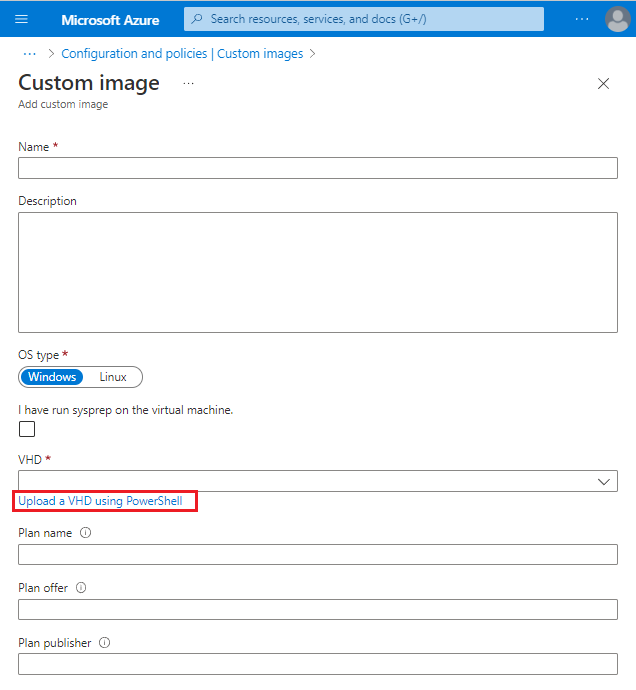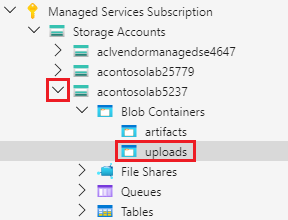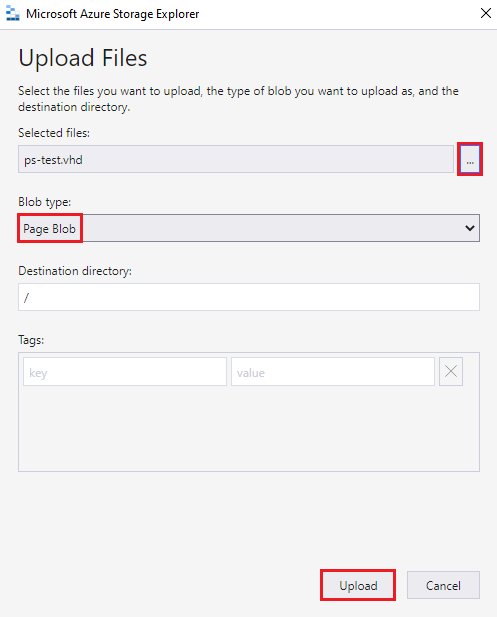Upload a VHD file to a lab storage account by using Storage Explorer
In this article, learn how to use Azure Storage Explorer to upload a VHD file to a lab storage account in Azure DevTest Labs. After you upload your VHD file, you can create a custom image from the uploaded VHD file and use the image to provision a virtual machine.
For more information about disks and VHDs in Azure, see Introduction to managed disks.
Storage Explorer supports several connection options. This article describes how to connect to a storage account that's associated with your Azure subscription. For information about other Storage Explorer connection options, see Get started with Storage Explorer.
Prerequisites
- Download and install the latest version of Storage Explorer.
To upload a VHD file to a lab storage account by using Storage Explorer, first, get the lab storage account name via the Azure portal. Then, use Storage Explorer to upload the file.
Get the lab storage account name
To get the name of the lab storage account:
Sign in to the Azure portal.
Select All resources, and then select your lab.
In the lab menu under Settings, select Configuration and policies.
In Activity log, in the resource menu under Virtual machine bases, select Custom images.
In Custom images, select Add.
In Custom image, under VHD, select the Upload an image using PowerShell link.

In Upload an image using PowerShell, scroll right to see a call to the Add-AzureRmVhd cmdlet.
The
-Destinationparameter contains the URI for a blob container in the following format:https://<storageAccountName>.blob.core.windows.net/uploads/...
Copy the storage account name to use in the next section.
Upload a VHD file
To upload a VHD file by using Storage Explorer:
When you open Storage Explorer, the Explorer pane shows all the Azure subscriptions you're signed in to.
If you need to add a different account, select the Account Management icon. In Account Management, select Add an account.

Follow the prompts to sign in with the Microsoft account associated with your Azure subscription.
After you sign in, the Explorer pane shows the Azure subscriptions that are associated with your account. Select the dropdown arrow next to the Azure subscription you want to use. The left pane shows the storage accounts that are associated with the selected Azure subscription.

Select the dropdown arrow next to the lab storage account name you saved earlier.
Expand Blob Containers, and then select uploads.

In the Storage Explorer right pane, on the blob editor toolbar, select Upload, and then select Upload Files.

In the Upload Files dialog:
Select ... next to Selected files. Go to the VHD file on your computer, select the file, and then select Open.
For Blob type, select Page Blob.
Select Upload.

Check the Activities pane at the bottom of Storage Explorer to see the upload status. Uploading the VHD file might take a long time, depending on the size of the VHD file and your connection speed.

Automate uploading VHD files
To automate uploading VHD files to create custom images, use Azure Storage Explorer. Storage Explorer is a standalone app that runs on Windows, OS X, and Linux.
To find the destination storage account that's associated with your lab:
- Sign in to the Azure portal.
- On the left menu, select Resource Groups.
- Find and select the resource group that's associated with your lab.
- Under Overview, select one of the storage accounts.
- Select Blobs.
- Look for uploads in the list. If none exists, return to step 4 and try another storage account.
- Use the URL as the destination for your VHDs.
Next steps
Feedback
Coming soon: Throughout 2024 we will be phasing out GitHub Issues as the feedback mechanism for content and replacing it with a new feedback system. For more information see: https://aka.ms/ContentUserFeedback.
Submit and view feedback for